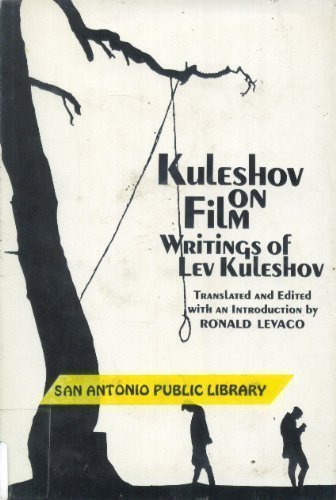Kuleshov on Film: Writings by Lev Kuleshov pdf download
Par martin joan le jeudi, juillet 21 2016, 04:00 - Lien permanent
Kuleshov on Film: Writings by Lev Kuleshov. Lev Vladimirovich Kuleshov, Ronald Levaco

Kuleshov.on.Film.Writings.by.Lev.Kuleshov.pdf
ISBN: 0520026594,9780520026599 | 121 pages | 4 Mb

Kuleshov on Film: Writings by Lev Kuleshov Lev Vladimirovich Kuleshov, Ronald Levaco
Publisher: Univ of California Pr
Source: http://www.imdb.com/name/nm0474487/bio : accessed on 12/9/2012. There was a lot more action in this film and he followed the action throughout the story. The Kuleshov effect is a film editing technique that was recognised and demonstrated by Russian filmmaker Lev Kuleshov between 1910-1920 during his montage experiments. Kuleshov's students included In the next few years, Kuleshov's former students would produce three now-classic revolutionary entertainment films: Eisenstein's Strike (1924) and Battleship Potemkin (1925), and Pudovkin's own Mother (1926). Pontypool And Other Zombie Films: Nothing To Do With The Living Dead · Hungry For Life, Thirsty For Lev Kuleshov was the grandfather of Russian Montage, often considered to be the world's first school of film theory. In the early 20th century, Russian filmmaker and theorist Lev Kuleshov discovered that a single shot of an actor with an ambiguous expression on his face could convey a multitude of very distinct meanings in the mind of the viewer, depending on the nature of the shot immediately preceding it. The younger director and theorist Lev Kuleshov, who believed in the central importance of editing to the filmmaking process, ran an influential workshop there that helped to birth montage theory. In 1918 he conducted his famous experiment (below) using a single shot of the silent film actor Ivan Mozzhukhin's face looking at something off-camera. He also started moving the cameras. The Montage theorists, such P.S.: Hopefully this weekend I will be writing my epic rant on “JRPGs” as a genre; I was going to wait a while to do so, but Extra Credits have recently posted a three-part video series that I want to respond to. It's a little hard to pin down precisely what the nature of his experiment was. The Kuleshov effect takes its name from Lev Kuleshov, an influential filmmaker in the mid-twentieth century Soviet Union, who illustrated it. He and his contemporary, Lev kuleshov, two of the earliest film theorists, argued that montage was the essence of the cinema. Eisenstein was a pioneer in the use of montage, a specific use of film editing. So basically the Kuleshov effect is a cinematic editing technique that was developed by this Russian bloke Lev Kuleshov in the early 20th century. Vsevolod Pudovkin (1893- 1953).